
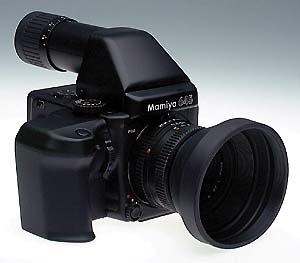
The goal of rollfilm manufacturers right now is to muscle in on the higher end of the 35mm market as uncertainty about the new Advanced Photo System, rising prices and complex specifications slow down sales.
With rollfilm bodies and lenses now costing no more than 35mm system lenses of similar performance, and no threat to rollfilm quality from the smaller-than-35mm format of APS, sales of 645 systems could boom.
If APS had offered a larger format than 35mm - by eliminating sprockets and having a frame 30 x 40mm in size - 645 would have been under threat. Instead, the 42 x 56mm true size of this format is even more attractive.
Seasoned 35mm users want exposure automation and motor-drive even when they have no need for AF in studio still life, portraiture, landscape and architectural work. Auto exposure is invaluable for social photography and very useful for general commercial and scenic work, while motordrive or auto-winding is vital for fashion and portrait shots.
The 645 format demands eye-level viewing. It is at its least satisfactory with a waist-level finder, almost impossible to use for vertical compositions, and far easier to work with once a prism is added. Eye-level use increases the need for the motordrive with its convenient right-hand grip.
All these can add greatly to the cost and weight of a standard 645 SLR. A camera which appears to have a cost of around 1,000 pounds ($1,500) - less than most professional 35mm SLRs - turns out to have no form of exposure metering, a waist-level finder, and a crank-handle wind-on. Adding a metering or auto-exposure prism and winder can double the price.
Mamiya's latest version of the 645 is, therefore, a deliberate attempt to provide a complete rollfilm SLR which performs like a manual focus TTL aperture priority metered 35mm model with auto-winder, while costing more at around 1,500 pounds than a complete standard professional AF 35mm SLR such as the Canon EOS-1n or Nikon F4, or high-end manual model like the Olympus OM-3Ti or Contax S2. This has been achieved by replacing the glass pentaprism with a hollow mirror viewfinder of much lighter weight, sacrificing detailed exposure information, and including the new lightweight Power Drive Grip WG402 which runs from a single 6v 2CR5 lithium cell.
The question you must ask, when considering this camera, is whether or not the AE Finder FK402 viewfinder/metering system - which can not be used on the Super - is adequate for professional use.
The film magazine is again the standard 645 Pro model, and is an excellent design, much improved for loading, first frame advance, noise level and general handling.

The new motor winder is a great improvement on earlier models, with a simplified on-off switch and no tendency to fail unexpectedly due to weak batteries. In this case, using a lithium cell has greatly improved the performance, weight and ergonomics of the winder. It is smooth, positive, has a well-positioned shutter release with a first pressure zone which only once or twice fired a frame when intending only to take a meter reading.

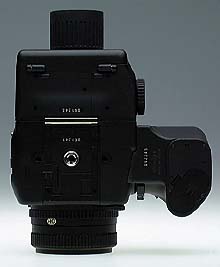
The viewfinder is not in the same category. Its very light weight may improve the balance of the camera for eye-level work, but the small exit pupil size makes it the exact reverse of a high-eyepoint system. You have to centre your eye precisely and the �5 dioptres eyepiece adjustment is absolutely necessary, as spectacle wearers just can't see the frame. The design does give excellent clearance when fitting rollfilm and Polaroid backs.
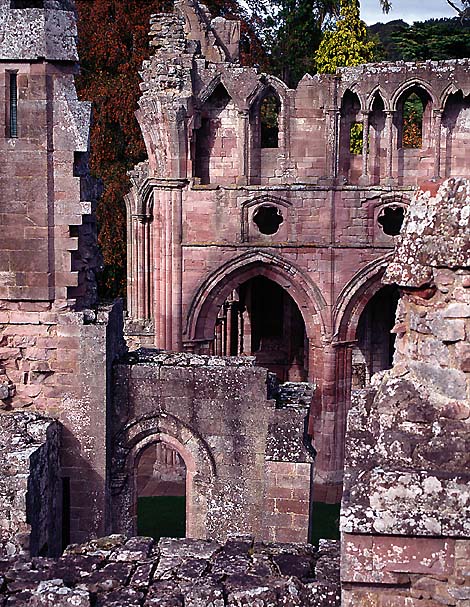
Dryburgh Abbey, Melrose, Scotland - a difficult composition to line up vertical as it was hard to tell whether the 55-110mm zoom lens or the finder itself was contributing to curvature of straight lines, and when any of these were parallel to the barrel-distorted frame of the finder. Auto exposure with the filmspeed set to 2/3rds of a stop higher than normal, to give reduced exposure and compensate for absence of sky.
The view through this mirror-prism is dim and barrel distorted, and gives only a 79% image scale with the 80mm lens. The distortion made it hard to judge verticals easily. The 94 percent field of view is commendable; most prism finders for rollfilm cut off huge amounts of usable frame, in an attempt to reduce size and weight. This mirror finder has no such restrictions and is shows more of the frame than most professional 35mm SLRs now do.
The metering system lacks a shutter speed display. It uses four LEDs which light up, extinguish, and flash either fast or slow in a sequence of cryptic combinations. As an example, a top orange AE LED lit and the central green LED lit with no other lights on means an exposure of 1/250. If the LED below the central one comes on, you're down to 1/60-1/125 and if it flashes at 2MHz while the green one extinguishes, between 1/30 and 1/15. In all there are eight states of LED on/off/blink.
I memorised the combinations, but two days later had forgotten them. There is an AE Lock setting, but no factorial over-ride, so bracketing on auto means twisting the ISO speed dial on the film magazine back and forth. There isn't even a backlight button for a quick +1 boost.
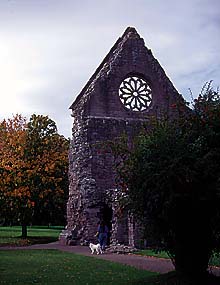
This was the not-too-impressive result of auto exposure in slightly backlit conditions - with no override or backlight button to resort to
Exposure with this prism is nominally centre-weighted, but it seemed very sensitive to bright skies or backlight and our sample consistently under-exposed Fujichrome Provia 100. On auto, exposure variation frame to frame was noticeable in a way which doesn't happen with modern matrix metering systems.
Given the lack of clear information from the LED system, most users would revert to manual exposure, which enjoys a rather more logical use of the LED array to show with clarity plus and minus settings in half-stop steps two stops either way. Mamiya would have been better off limiting this finder to manual; then I would have had no complaints about the metering, as it is manual practice to exclude bright skies (etc) or use a grey card, and setting the shutter speed and aperture makes the user far more aware of variations.
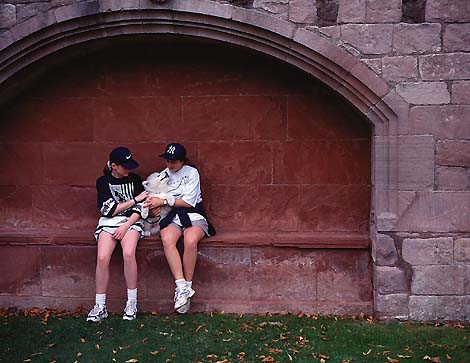
Effectively a manual exposure, though taken on auto with adjusted filmspeed. I would use this finder as a manual meter out of preference.
Where it fails is as a professional AE prism. Here, the original, heavier but far superior AE Prism Finder FE401 with its over-ride settings and multiple modes is so much better that no cash saving is really worth the sacrifice.
At the other end of the scale, for the entry-level user, I'm not sure that it offers sufficient moron-proofing. The variability of exposure depending on subject and lighting conditions is too great, and there's no easy over-ride control. New users, expecting a point-and-shoot rollfilm SLR, may be disappointed at results compared to today's almost infallible 35mm compacts.
However, the FK402 finder is far better than a waist-level finder and as good as any manual metering prism. Its light weight, wide dioptric adjustment and 94 percent frame view help offset the dim image and curved geometry.